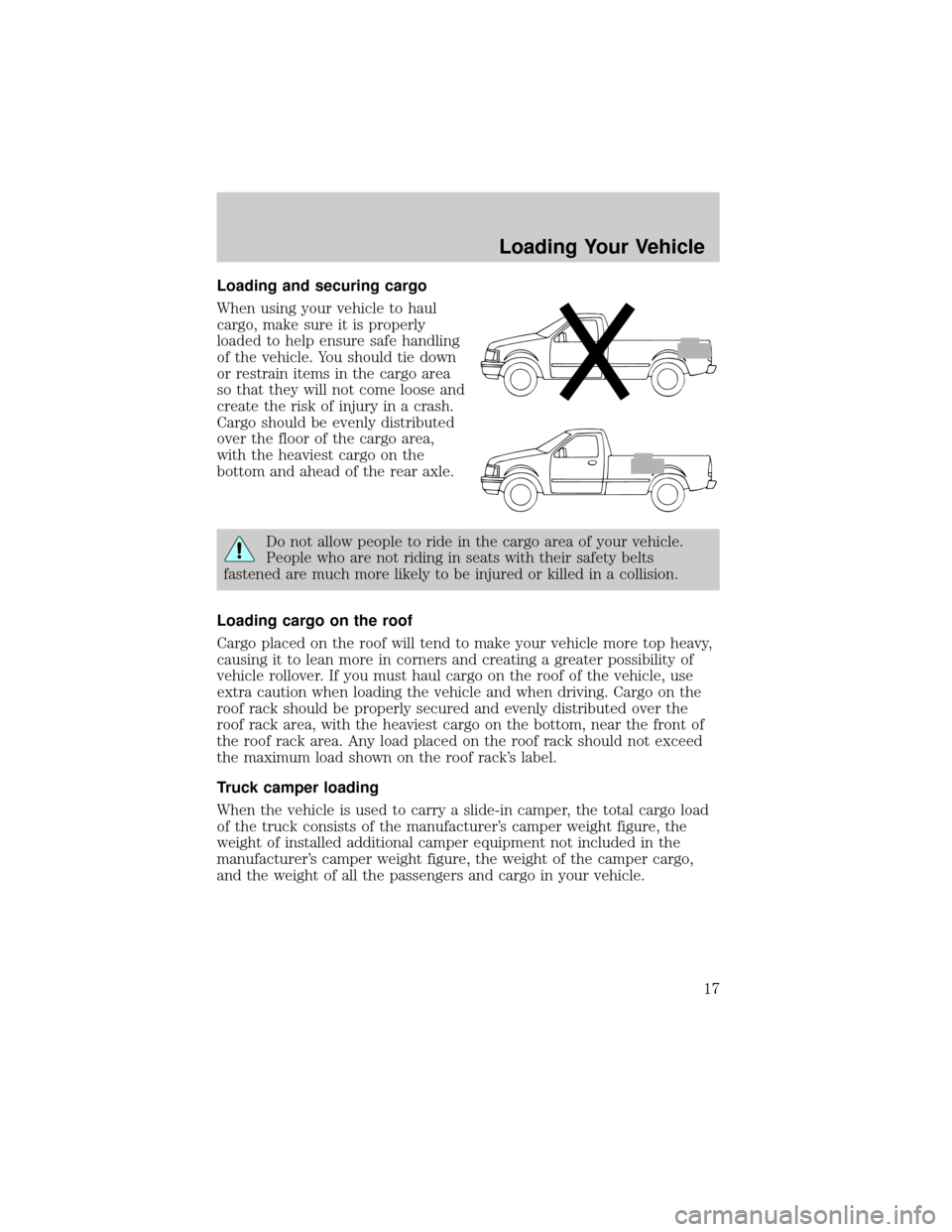Page 41 of 48

Loading and securing cargo
When using your vehicle to haul
cargo, make sure it is properly
loaded to help ensure safe handling
of the vehicle. You should tie down
or restrain items in the cargo area
so that they will not come loose and
create the risk of injury in a crash.
Cargo should be evenly distributed
over the floor of the cargo area,
with the heaviest cargo on the
bottom and ahead of the rear axle.
Do not allow people to ride in the cargo area of your vehicle.
People who are not riding in seats with their safety belts
fastened are much more likely to be injured or killed in a collision.
Loading cargo on the roof
Cargo placed on the roof will tend to make your vehicle more top heavy,
causing it to lean more in corners and creating a greater possibility of
vehicle rollover. If you must haul cargo on the roof of the vehicle, use
extra caution when loading the vehicle and when driving. Cargo on the
roof rack should be properly secured and evenly distributed over the
roof rack area, with the heaviest cargo on the bottom, near the front of
the roof rack area. Any load placed on the roof rack should not exceed
the maximum load shown on the roof rack's label.
Truck camper loading
When the vehicle is used to carry a slide-in camper, the total cargo load
of the truck consists of the manufacturer's camper weight figure, the
weight of installed additional camper equipment not included in the
manufacturer's camper weight figure, the weight of the camper cargo,
and the weight of all the passengers and cargo in your vehicle.
Loading Your Vehicle
17
Page 42 of 48
The total cargo load should not exceed the truck's cargo weight rating
and the camper's center of gravity should fall within the trucks's
recommended center of gravity zone when installed. For more
information refer to your truck camper loading label.
Do not allow people to ride in a slide-in camper. People who are
not riding in seats with their safety belts fastened are much
more likely to be injured or killed in a collision.
Loading Your Vehicle
18
Page 43 of 48
TRAILER TOWING
Your vehicle may be equipped for towing trailers (or may require a trailer
tow package). Before you operate your vehicle with a trailer, make sure
that you comply with the guidelines in the ªRV & Trailer Towing Guideº.
The combined total weight of the vehicle and trailer must be less than or
equal to the recommended Gross Combination Weight Rating (GCWR)
and be properly balanced and secured. Refer to ªRV & Trailer Towing
Guide,º the ªOwner's Guideº or see an authorized Ford or
Lincoln/Mercury Dealer for additional information.
Trailer Towing
Trailer Towing
19
Page 44 of 48

MAINTENANCE AND MODIFICATIONS
The suspension and steering systems on your vehicle have been carefully
designed to provide safe, predictable performance and durable load
carrying capability. Do not make modifications such as adding or
removing parts (such as lift kits or stabilizer bars) or using replacement
parts not equivalent to the original factory equipment because these
modifications can affect the safety of your vehicle.
Do not use ªaftermarket lift kitsº or other suspension
modifications. ªAftermarket lift kitsº could adversely affect the
vehicle's handling characteristics, which could result in an increased
risk of loss of vehicle control, vehicle rollover, personal injury and
death.
Any modifications to a vehicle that raise the center of gravity can make
it easier to induce vehicle rollover. Ford recommends that you take extra
precautions, such as driving at lower speeds, avoiding abrupt steering
changes and allowing for increased stopping distance, for any vehicle
equipped with a high load (for example, roof racks).
Failure to maintain your vehicle properly may void the warranty, increase
your repair cost, reduce vehicle performance and operational capabilities
and adversely affect driver and passenger safety. Frequent inspection of
vehicle chassis and powertrain components is recommended if the
vehicle is subjected to heavy off-road usage. Refer to the ªOwner's
Guideº and ªService Guideº for proper maintenance instructions and
schedules.
Maintenance and Modifications
Maintenance and Modifications
20
Page 45 of 48
Page 46 of 48
Page 47 of 48
Page 48 of 48